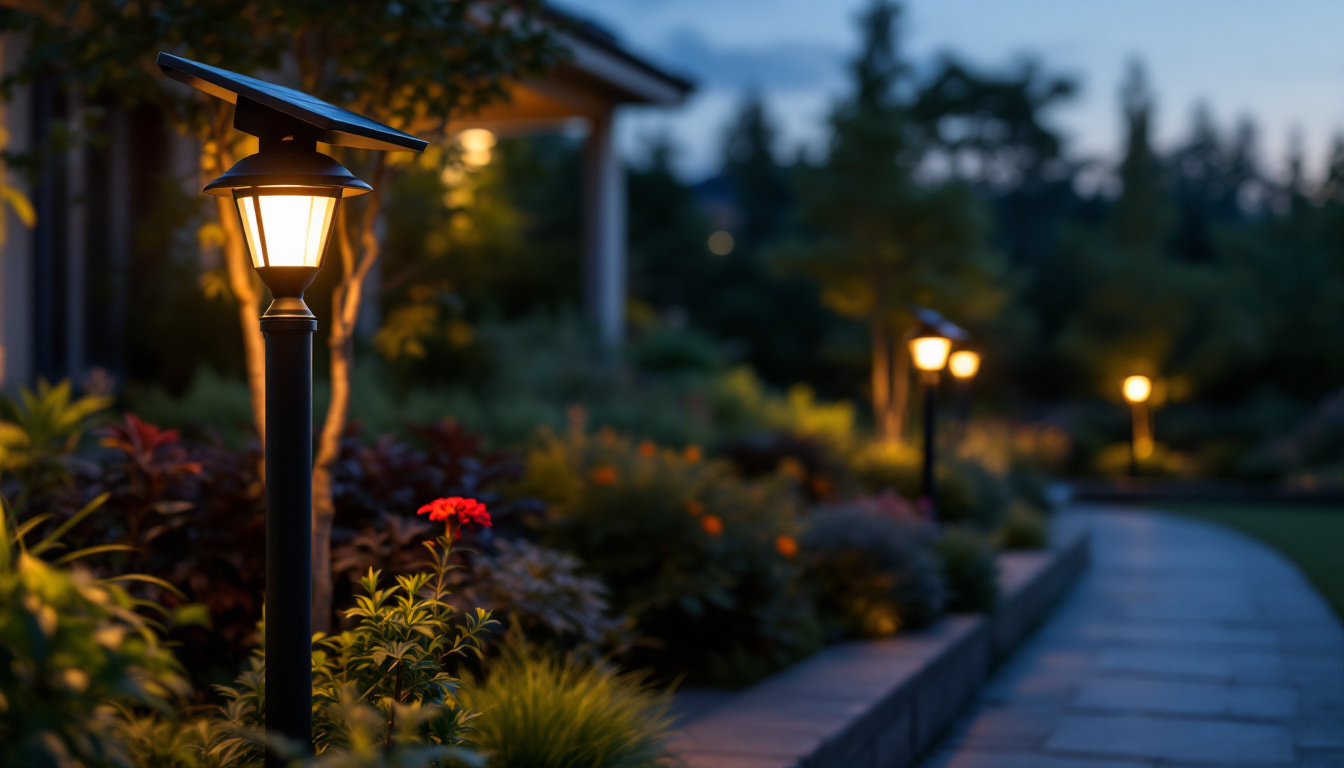
Outdoor solar post lights have become increasingly popular among homeowners and businesses alike, offering an eco-friendly and cost-effective lighting solution. For lighting contractors, understanding the intricacies of solar post lights is essential for successful installation and customer satisfaction. This checklist will guide contractors through the key considerations, components, and installation steps necessary to ensure a seamless process and optimal performance of outdoor solar post lights.
Before diving into the installation process, it’s crucial to understand what solar post lights are and how they operate. These lights harness solar energy to illuminate outdoor spaces, making them an attractive option for various applications.
Solar post lights are outdoor lighting fixtures that are mounted on posts, typically used for pathways, gardens, decks, and patios. They contain solar panels that convert sunlight into electricity, which is stored in rechargeable batteries. At night, the stored energy powers the LED bulbs, providing illumination without the need for electrical wiring.
These lights come in a variety of styles and designs, ranging from traditional lantern-like fixtures to sleek, modern designs. This diversity allows homeowners to choose solar post lights that not only serve a functional purpose but also enhance the aesthetic appeal of their outdoor spaces. Some models even feature decorative elements like glass shades or intricate metalwork, adding a touch of elegance to gardens and walkways.
One of the primary advantages of solar post lights is their energy efficiency. By relying on renewable solar energy, they significantly reduce electricity costs. Additionally, their easy installation process eliminates the need for extensive wiring, making them a convenient choice for contractors and homeowners alike.
Moreover, solar post lights are often equipped with motion sensors and timers, allowing for enhanced security and energy savings. Their versatility in design and functionality also means they can complement a variety of outdoor aesthetics. Beyond aesthetics, many solar post lights are built to withstand various weather conditions, featuring durable materials that resist rust and corrosion. This resilience ensures that they remain functional and visually appealing for years, even in harsh climates.
Furthermore, the environmental benefits of solar post lights cannot be overlooked. By utilizing solar energy, these lights contribute to reducing carbon footprints and promoting sustainable living. As more people become aware of their ecological impact, the popularity of solar post lights continues to rise, making them a smart choice for eco-conscious homeowners looking to illuminate their outdoor spaces responsibly.
Understanding the various components of solar post lights is essential for contractors to ensure proper selection and installation. Each component plays a vital role in the overall performance and longevity of the lighting fixture.
The solar panel is the heart of the solar post light, responsible for converting sunlight into electrical energy. Contractors should ensure that the panels are made from high-quality materials, such as monocrystalline or polycrystalline silicon, which offer better efficiency and durability.
It’s also important to consider the size of the solar panel, as larger panels can capture more sunlight and generate more power, leading to longer illumination times during the night.
LED bulbs are favored in solar post lights for their energy efficiency and long lifespan. When selecting LED bulbs, contractors should look for those with a high lumen output to ensure adequate brightness for the intended area. Additionally, the color temperature of the bulbs can affect the ambiance; warmer tones may be suitable for residential settings, while cooler tones might be preferred for commercial spaces.
The battery stores the energy generated by the solar panel, allowing the light to function during the night. Lithium-ion batteries are commonly used due to their longevity and efficiency. Contractors should verify the battery capacity to ensure it can provide sufficient power for the desired duration of illumination.
Proper installation is critical for the performance of solar post lights. Contractors must take several factors into account to ensure that the lights operate effectively and meet the client’s expectations.
Before installation, a thorough site assessment is necessary. Contractors should evaluate the area’s sunlight exposure, as insufficient sunlight can lead to poor performance of solar lights. Ideally, the lights should be placed in locations that receive direct sunlight for several hours each day.
Additionally, contractors should consider potential obstacles, such as trees or buildings, that may cast shadows on the solar panels. A clear understanding of the site will help in determining the optimal placement of the lights.
The height at which solar post lights are installed can significantly impact their effectiveness. Generally, a height of 3 to 4 feet is recommended for pathways and gardens, while higher placements may be suitable for larger areas or commercial settings.
Contractors should also ensure that the lights are spaced appropriately to provide uniform illumination. A common guideline is to place lights 10 to 15 feet apart, depending on the brightness of the bulbs and the area being illuminated.
Stability is key to the longevity of solar post lights. Contractors should ensure that the posts are securely anchored in the ground, using concrete or other stabilizing materials as necessary. This will prevent the lights from tipping over or being damaged by wind or other environmental factors.
To ensure that solar post lights continue to operate effectively over time, regular maintenance is essential. Contractors should educate clients on simple maintenance tasks that can prolong the life of their solar lighting systems.
Dust, dirt, and debris can accumulate on solar panels, reducing their efficiency. It is advisable to clean the panels regularly, especially after storms or windy conditions. A soft cloth or sponge with mild soap and water can effectively remove grime without scratching the surface.
Over time, batteries may lose their ability to hold a charge. Contractors should inform clients about the signs of battery failure, such as dimming lights or shorter illumination periods. Regularly checking and replacing batteries will ensure optimal performance of the solar post lights.
Regular inspections can help identify any physical damage to the solar post lights. Contractors should advise clients to check for cracks, loose components, or any signs of wear and tear. Addressing these issues promptly can prevent further damage and maintain the aesthetics and functionality of the lighting system.
While solar post lights offer numerous benefits, contractors may encounter challenges during installation and maintenance. Understanding these challenges and having solutions at hand can enhance the overall experience for both contractors and clients.
One of the most common challenges is insufficient sunlight exposure, which can lead to inadequate charging of the solar panels. If a site has limited sunlight, contractors may recommend alternative lighting solutions or suggest relocating the solar lights to a sunnier spot.
Another option is to install solar lights with larger panels or higher-capacity batteries, which can help mitigate the effects of limited sunlight.
Battery performance can be affected by temperature fluctuations, particularly in extreme climates. Contractors should recommend solar post lights designed to withstand various weather conditions, ensuring that the batteries remain functional in both hot and cold environments.
Additionally, educating clients on the importance of battery maintenance can help prevent performance issues.
Variability in light output can occur due to differences in solar panel efficiency or battery capacity. Contractors should ensure that all components are compatible and of high quality to maintain consistent performance across all lights in a system.
Providing clients with information on the expected performance of their solar post lights can help manage expectations and enhance satisfaction.
With a plethora of options available on the market, selecting the right solar post lights can be a daunting task for contractors. Several factors should be considered to ensure the chosen lights meet the specific needs of the project.
The design of solar post lights should complement the surrounding environment. Contractors should consider the architectural style of the property and the intended use of the lighting. Options range from traditional lantern styles to modern sleek designs, allowing for a wide variety of choices to suit different tastes.
Contractors should assess the brightness requirements based on the intended application. For pathways, softer lighting may be sufficient, while brighter lights may be necessary for security purposes. Additionally, features such as motion sensors and adjustable brightness settings can enhance functionality and energy efficiency.
Given that solar post lights are exposed to the elements, durability is a key consideration. Contractors should select lights made from weather-resistant materials, such as stainless steel or high-grade plastic, to ensure longevity. Checking for an IP rating can also provide insight into the light’s resistance to moisture and dust.
Outdoor solar post lights represent a significant advancement in sustainable lighting solutions, offering both environmental benefits and aesthetic appeal. For lighting contractors, understanding the intricacies of these fixtures is essential for successful installation and customer satisfaction.
This checklist serves as a comprehensive guide, covering everything from the fundamental components of solar post lights to installation considerations and maintenance tips. By following these guidelines, contractors can ensure that their solar post light installations are efficient, effective, and tailored to meet the unique needs of their clients.
Ultimately, the right approach to solar post lighting can not only enhance outdoor spaces but also contribute to a greener future, making it a win-win for contractors and their clients alike.
Ready to elevate your lighting installations with the best in solar post lights? At LumenWholesale, we provide lighting contractors like you with the highest quality, spec-grade lighting products at unbeatable wholesale prices. Say goodbye to local distributor markups and hello to our extensive selection that meets rigorous industry standards. With free shipping on bulk orders, you can trust that you’re getting premium lighting at the best value — no hidden fees, no compromises. Enhance your outdoor lighting projects and contribute to a sustainable future with LumenWholesale. Wholesale Lighting at the Best Value.

Discover the fascinating history of the light bulb and explore essential best practices for modern lighting contractors.

Discover how hanging garden lights are revolutionizing outdoor spaces with innovative design and easy installation.

Discover the key considerations and benefits of high hat lights for lighting contractors.

Discover the ultimate guide for lighting contractors on pendant lighting fixtures.